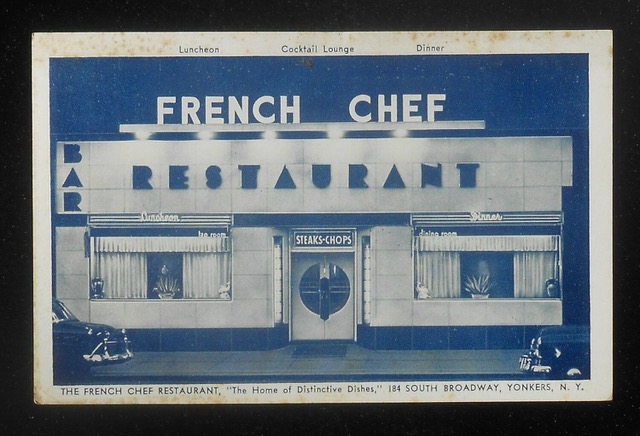
A postcard of the the French Chef Restaurant, 184 South Broadway, Yonkers
By Mary Hoar, City of Yonkers Historian, President Emerita Yonkers Historical Society, recipient of the 2004 Key to History, Member of the Yonkers Landmarks Preservation Board, Chair of Revolutionary Yonkers 250 and President Untermyer Performing Arts Council
Monday, August 26th
August 26, 1946: Relentless work by YPD Detectives turned a small clue— a drycleaner’s mark on a jacket—into an arrest! Harvey Glatman from Denver robbed a couple on Worth Street near the Nepperhan River. Glatman tied Dolores Thorne to a tree after stabbing and robbing her companion Thomas Staro, owner of a nearby fruit store. Staro managed to free his hands, then fought the assailant. At the time, YPD was a few blocks away, investigating the mugging of two sisters by the same perpetrator.
Arriving at the scene, detectives found a toy gun and a sports jacket. Yonkers detectives visited hundreds of metropolitan area dry-cleaning stores until they found the store in Brooklyn that cleaned the jacket. They determined the owner of the jacket and got his name. YPD sent out a national alarm, resulting in Denver Police sending Glatman’s picture. That led to his capture; he was arrested in Albany for a similar crime. Yonkers Judge Boote immediately signed the warrant for Glatman’s arrest. Detectives Albert Hoffarth and Robert Schegel immediately headed to Albany with the warrant in hand. Two other detectives, Dominick Cuccia and Louis Ligay, assisted in the investigation.
Tuesday, August 27th
August 27, 1942: Seventy National Health Foods Association’s convention delegates traveled to Yonkers to eat an unusual lunch at the French Chef. All, guests of the American Diet Aids Company at176 South Broadway, were given a lunch of vitamin capsules, calcium tablets, wheat germ muffins, vitamin fortified candy, and coffee substitute. They also were given a “real meal” seasoned with Diet Aids’ salt substitute.
August 27, 1951: Former florist and Park Superintendent Louis Milliot announced the small tree growing from the roof of historic St. John’s Episcopal Church probably was an ailanthus, sometimes called the “tree of heaven.”
The Herald Statesman story on the tree became international news; St. John’s Church Rector Reverend Winterbottom, vacationing in Europe, read about his church in the European version of the New York Herald Tribune!
Wednesday, August 28th
August 28, 1920: Plant Manager Edward Fitch announced sixty-three striking workers at the Otis Elevator Company in Yonkers were discharged for complicity in calling the strike.
August 28, 1943: Councilman Edith Welty proposed removing the Mayor from the Board of Compromise and Settlement, replacing him with the City Manager. She suggested this action because the Board compromised a $1, 269 tax lien against aqueduct builders Shea and Kaiser with a $1 settlement.
To replace the Mayor, the Council would have to pass a Local Law which then would become a mandatory referendum the public needed to vote on; any limitation or change of an elected official’s power had to be approved by voters. Members of the board were the Mayor, Tax Commissioner, Comptroller and Corporation Council. The City Clerk was the Board Secretary.
Thursday, August 29th
August 29, 1906: William B. Thompson, banker and broker, purchased the J. K. Myers estate on the west side of North Broadway, north of Odell Avenue. He planned to build a residence on the 15-acre plot. The estate adjoined the Norris property, recently purchased by J. B. Duke, President of the American Tobacco Company. The property now is the Boyce Thompson Academy.
August 29, 1934: Sister Mary Carmela, Superintendent of St. Joseph’s Hospital, demonstrated a new device to give patients’ quick response to their needs. A black frame was on her desk. If a number lit up in the frame, a patient was calling for a nurse. If it didn’t go out in thirty seconds, the system “broadcast the need for a nurse.” The good sister explained it promised patients “new comfort and immediate service.”
Friday, August 30th
August 30, 1940: The Yonkers Branch of the Westchester County Council for the National Defense adopted a resolution asking the President and Congress to sell ships, planes and guns to Great Britain.
August 30, 1945: Yonkers people began noticing signs the war was over. Groups of men began standing in Getty Square, just as they did in prewar days. Cigarettes were displayed on racks behind the counter, just as in the prewar days. During the war, shop owners had hidden more popular brands for their favorite customers. And most telling, car owners pulled into gas stations and told the attendants, “Fill it up,” just as in the prewar days.
Saturday, August 31st
August 31, 1932: Colonel A. Pearson Hoover, Yonkers Planning Commission, announced the Commission was studying plans for a bridge across the Hudson at Trevor Park. Pearson noted the committee was aware of the enormous size of the project, but believed there was a need for an additional bridge between the existing bridges, the Bear Mountain Bridge and the George Washington Bridge. The bridge would be connected to a Westchester parkway and paid for by the Reconstruction Finance Corporation with money “allocated to self-liquidating projects.”
The proposal later was presented to the Port of New York Authority after all needed data was collected.
Sunday, September 1st
September 1, 1932: Antonio Orlando, digging a foundation at 87 Cowdrey Avenue, uncovered a very old skeleton, a rusty nail and a corroded screw in Yonkers’ Homewood neighborhood. He found it one day after an old skull was found. The bones, found four feet underground, were buried many years earlier. According to YPD, no investigation would be made because of the length of time the body was buried.
Over the years, multiple skeletons were found in the area; once the Rice estate, it was the site of a Revolutionary War skirmish!
Questions or comments on this column? Email YonkersHistory1646@gmail.com.
For information on the Yonkers Historical Society, Sherwood House and upcoming events, please visit our website www.yonkershistoricalsociety.org, call 914-961-8940 or email info@yonkershistoricalsociety.org





